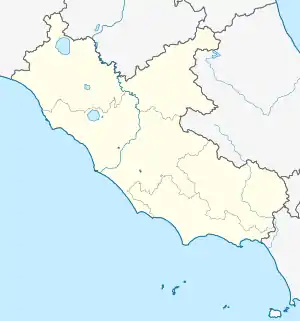San Giovenale
San Giovenale is the modern name of the location of an ancient Etruscan settlement close to the modern village of Blera, Italy. It was excavated by the Swedish Institute at Rome in the 1950s and 1960s with King Gustaf VI Adolf as one of the participating archaeologists.[1] The excavations at San Giovenale has been, together with the excavations of Acquarossa, the main source of information about how small and medium-size Etruscan settlements were organized.[2][3]
 The Borgo of San Giovenale, with remains of Etruscan houses and workshops. | |
 Shown within Lazio | |
| Location | Comune di Blera, Italy |
|---|---|
| Region | Lazio |
| Type | Settlement |
| History | |
| Abandoned | Roman period |
| Periods | Neolithic period - Roman Republic |
| Cultures | Etruscan |
| Site notes | |
| Excavation dates | yes |
| Archaeologists | Swedish Institute at Rome; Eric Berggren |
| Condition | ruined |
| Public access | no |
| Website | San Giovenale (in English) |
The site
The main settlement consists of high plateau split in two parts, normally referred to as the Acropolis and the Borgo.[4] The settlement is surrounded by a number of burial sites.
References
- Eric Berggren; Kristina Berggren (1981). San Giovenale: Excavations in Area B, 1957-1960. Distributor P. Aströms. ISBN 978-91-7042-078-8.
- The Etruscans, Graeme Barker & Tom Rasmussen, page 158
- Bertil Hallert; Svenska institutet i Rom; Italy. Soprintendenza alle antichità dell'Etruria meridionale (1981). San Giovenale: Results of excavations conducted by the Swedish institute of classical studies at Rome and the Soprintendenza alle antichità dell'Etruria meridionale. Gleerup. ISBN 978-91-7042-078-8.
- The Etruscans, Graeme Barker & Tom Rasmussen, page 320
External links
- San Giovenale, The Swedish Institute at Rome
- San Giovenalo, Amministrazione provinciale di Viterbo
This article is issued from Wikipedia. The text is licensed under Creative Commons - Attribution - Sharealike. Additional terms may apply for the media files.